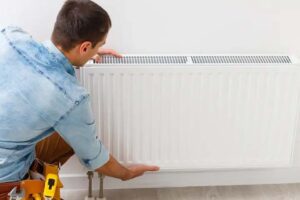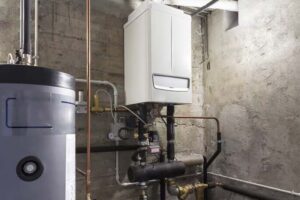Table of Contents
If your ESI thermostat is not working well, it can be frustrating. But it’s important to remember that many problems can be fixed by simply troubleshooting. At Grant Boilers, we are pleased to help you maintain a cosy and efficient home heating system. This detailed guide will cover some general ESI thermostat problems. And it also provides practical troubleshooting tips to help you resolve them.
Understanding ESI Programmable Room Thermostat Working
Before repairing, you should know how your ESi thermostat generally works. ESi Controls is a line of programmable room thermostats designed to lower your costs and energy usage. And to help you manage your heating system more efficiently. You can set these thermostats to heat your home at times that work with your plan, but if they break, it can affect your comfort and energy use.
How Does an ESI Thermostat Work?
Naturally, each model of ESI thermostat functions differently, and it varies from model to model.
A thermostat is usually a heat-activated switch with an internal temperature sensor. That allows your heating system to change the temperature in your home. Its primary purpose is to ensure that your home is as close as possible to setting the right temperature for that given time.
ESI thermostats come with various programs, including a 7-day mode, 5/2-day mode, and 24-hour mode.
When working as expected, your ESI thermostat will follow the default heating schedule. Or the one you’ve set based on the operating mode selected.
Step By Step Repair Guide of ESI Thermostat Troubleshooting
The Obvious Checks
- Fixing an acting ESI thermostat generally involves some troubleshooting. Sometimes there is a straightforward fix.
- For one, double-check that it’s turned on.
- More than likely, you’ve already done this, but sometimes, we can be so focused on more complicated potential explanations. We expect to check the obvious.
- Furthermore, you should carefully check your circuit breakers to ensure they are operating. And that you’ve chosen Cool or Heat for your thermostat, depending on the time of year.
- You might even need to replace your thermostat’s batteries simply.
- It’s important that your thermostat has batteries with sufficient energy and that the batteries are installed correctly.
- Lastly, assuming that your thermostat is programmable, you’ll want to verify that all settings are correct and that you haven’t accidentally turned on the override function.
Clean Your Thermostat
Safety Note
Before cleaning the inside of your thermostat, make sure that you turn the power off on the mains. This will eliminate the risk of electrocution.
It’s also possible that your thermostat needs a little cleaning.
As dust and dirt gather on the inside of your thermostat over the months and years since installation, issues can arise by clogging its electrical and mechanical parts.
To address this potential problem, take the following steps:
- Gently open the case
- Clean the inside of your thermostat with a can of electronic air cleaner specifically made to clean electronics. Alternatively, you could use a small and suitable paintbrush. Just before, none of the thistles broke off and polluted the inside of the thermostat.
Always hire a professional if you need more clarification about performing this work.
After all, attempting to clean a thermostat DIY unless you know exactly what you’re doing could result in causing accidental damage.
Lack of Signal
One of the most common reasons an ESI thermostat stops working is that there is no signal. The manufacturer’s instructions for your specific ESI thermostat model will provide the necessary details. This helps you understand how to tell if there is no signal between your thermostat and receiver and how to fix it. Solutions can vary from model to model, so we cannot provide a concrete answer to fixing this problem.
Inspect the Anticipator
Safety Note
To adjust the anticipator, you’d need first to ensure that you turn off the power at the mains to avoid electrocution. Which could easily prove fatal.
Each ESI thermostat features a component known as the anticipator.
- When the room temperature and set temperature are almost a match, the anticipator will desensitise your thermostat’s ability to detect tiny temperature changes.
- This prevents your HVAC system from cycling on and off too often, which could harm the thermostat. The anticipator generally requires a power input of 0.2 to 0.8 amps to work correctly.
- It’s possible that the anticipator needs to adjust to work as intended.
- If you suspect this is the case, this should get your thermostat working correctly again. If your boiler turns on and off too often, you should change your anticipator to the ‘longer’ setting by a single calibration.
- Alternatively, if your boiler isn’t heating your home to a sufficient degree (pun, semi-intended), then you should move it by one calibration mark to the ‘shorter’ setting.
- Once you’ve performed either of these steps, give it an hour or two before determining whether or not it’s fixed the problem.
- Again, if in doubt, hire a qualified professional to inspect and adjust your thermostat’s anticipator if required.
Is it in the Right Location and Balanced Correctly?
A thermostat must be located in a suitable spot and balanced right to do its job continually.
Here are some reasons why moving your ESI thermostat may be necessary:
- Your thermostat is near electrical equipment.
- If the thermostat faces direct sunlight at least at some point during the day.
- When the ESI thermostat is exposed to any temperature extremes or draughts.
If you believe changing the location is a good bet, you may only do so if it is a wireless thermostat.
This is because moving a hardwired thermostat requires the work of an electrician or another suitable professional.
If it is wireless, you can try it once you follow the manufacturer’s instructions to a T and know precisely what you’re doing. If you have any questions, always hire a professional.
Replacing Your Thermostat
- While unlikely, your thermostat may need replacement. If it is inoperable and beyond economical repair. It would be best (if not the only option) to have it replaced.
- Depending on the type of thermostat you currently have. You might be interested in upgrading to a more sophisticated thermostat (e.g., swapping out an old hardwired thermostat for a modern WiFi-enabled one).
- Smart wireless thermostats can provide many unique advantages over hardwired thermostats, such as their ability to allow for remote control.
- With remote thermostat communication, such thermostats can often inform homeowners that they’ve left the heating at home. And allowing them to switch it off even if they are dozens of miles away with their smartphones.
- Moreover, you can use remote-controlled thermostats to turn on the heating while on your way home from work.
- While more expensive, intelligent wireless thermostats can offer great value for money.
Hiring a Professional to Fix Your ESI Thermostat
If you cannot safely fix your ESI thermostat yourself. You must hire a suitable professional. This is especially important. If you think the problem is with your home’s electrical system. Or if the thermostat shows error codes that aren’t explained in the instructions. Technicians are trained to find and fix problems. That is too complicated for regular people to do themselves.
Conclusion
ESi programmable room thermostat repairs are usually easy to do if you follow the right instructions. To get started, always look at the simplest options and read the user manual. However, don’t hesitate to get help from a professional. If the problem keeps happening or if you’re not sure how to fix something. With time and care, you can usually get your thermostat back to working. As it should, keeping your home comfortable and saving you money on energy costs.





